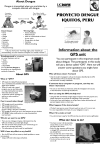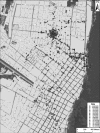Assessing and maximizing the acceptability of global positioning system device use for studying the role of human movement in dengue virus transmission in Iquitos, Peru
- PMID: 20348526
- PMCID: PMC2844550
- DOI: 10.4269/ajtmh.2010.09-0496
Assessing and maximizing the acceptability of global positioning system device use for studying the role of human movement in dengue virus transmission in Iquitos, Peru
Abstract
As use of global positioning system (GPS) technology to study disease transmission increases, it is important to assess possible barriers to its use from the perspective of potential study participants. Fifteen focus group discussions stratified by sex, age, and motherhood status were conducted in 2008 in Iquitos, Peru. All participants said they would accept using a GPS unit for study purposes for 2-4 weeks. Participants' main concerns included caring properly for the unit, whether the unit would audio/videotape them, health effects of prolonged use, responsibility for units, and confidentiality of information. A pilot study was then conducted in which 126 persons were asked to carry GPS units for 2-4 weeks; 98% provided consent. All persons used the units expressing minimal concerns, although 44% reported forgetting the device at least once. Our study is the first to highlight participant concerns related to use of GPS for long-term monitoring of individual behavior in a resource-limited setting.
Conflict of interest statement
Disclosure: None of the authors has a financial or personal conflict of interest related to this study. The corresponding author had full access to all data in the study and final responsibility for the decision to submit this publication.
Figures



Similar articles
-
Usefulness of commercially available GPS data-loggers for tracking human movement and exposure to dengue virus.Int J Health Geogr. 2009 Nov 30;8:68. doi: 10.1186/1476-072X-8-68. Int J Health Geogr. 2009. PMID: 19948034 Free PMC article.
-
Comparison of two active surveillance programs for the detection of clinical dengue cases in Iquitos, Peru.Am J Trop Med Hyg. 2009 Apr;80(4):656-60. Am J Trop Med Hyg. 2009. PMID: 19346395
-
Epidemiology of dengue virus in Iquitos, Peru 1999 to 2005: interepidemic and epidemic patterns of transmission.PLoS Negl Trop Dis. 2010 May 4;4(5):e670. doi: 10.1371/journal.pntd.0000670. PLoS Negl Trop Dis. 2010. PMID: 20454609 Free PMC article.
-
Strengths and weaknesses of Global Positioning System (GPS) data-loggers and semi-structured interviews for capturing fine-scale human mobility: findings from Iquitos, Peru.PLoS Negl Trop Dis. 2014 Jun 12;8(6):e2888. doi: 10.1371/journal.pntd.0002888. eCollection 2014 Jun. PLoS Negl Trop Dis. 2014. PMID: 24922530 Free PMC article.
-
Geographical information systems for dengue surveillance.Am J Trop Med Hyg. 2012 May;86(5):753-5. doi: 10.4269/ajtmh.2012.11-0650. Am J Trop Med Hyg. 2012. PMID: 22556070 Free PMC article. Review.
Cited by
-
The use of GPS data loggers to describe the impact of spatio-temporal movement patterns on malaria control in a high-transmission area of northern Zambia.Int J Health Geogr. 2019 Aug 19;18(1):19. doi: 10.1186/s12942-019-0183-y. Int J Health Geogr. 2019. PMID: 31426819 Free PMC article.
-
Disparities in mobile phone ownership reflect inequities in access to healthcare.PLOS Digit Health. 2023 Jul 6;2(7):e0000270. doi: 10.1371/journal.pdig.0000270. eCollection 2023 Jul. PLOS Digit Health. 2023. PMID: 37410708 Free PMC article.
-
Feasibility and Acceptability of Global Positioning System (GPS) Methods to Study the Spatial Contexts of Substance Use and Sexual Risk Behaviors among Young Men Who Have Sex with Men in New York City: A P18 Cohort Sub-Study.PLoS One. 2016 Feb 26;11(2):e0147520. doi: 10.1371/journal.pone.0147520. eCollection 2016. PLoS One. 2016. PMID: 26918766 Free PMC article.
-
Mapping populations at risk: improving spatial demographic data for infectious disease modeling and metric derivation.Popul Health Metr. 2012 May 16;10(1):8. doi: 10.1186/1478-7954-10-8. Popul Health Metr. 2012. PMID: 22591595 Free PMC article.
-
Theory and data for simulating fine-scale human movement in an urban environment.J R Soc Interface. 2014 Oct 6;11(99):20140642. doi: 10.1098/rsif.2014.0642. J R Soc Interface. 2014. PMID: 25142528 Free PMC article.
References
-
- Kuno G. Review of the factors modulating dengue transmission. Epidemiol Rev. 1995;17:321–335. - PubMed
-
- Gonzalez MC, Hidalgo CA, Barabasi A-L. Understanding individual human mobility patterns. Nature. 2008;453:779–782. - PubMed
-
- Schlich R. Measurement Issues in Identifying Variability in Travel Behaviour. Swiss Transport Research Conference; 2001.
Publication types
MeSH terms
Grants and funding
LinkOut - more resources
Full Text Sources
Medical
Research Materials

